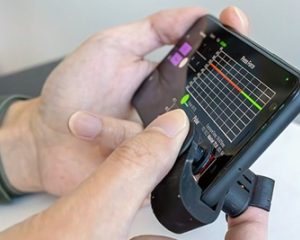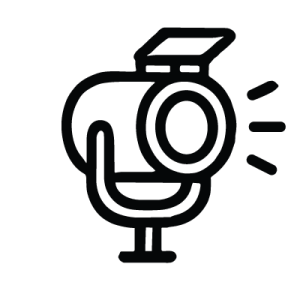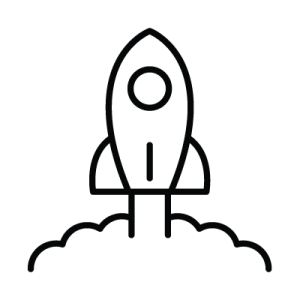Investigator:
Edward Jay Wang, UCSD
MassAITC Cohort: Year 1 (Aging)

Final Project Accomplishments: The pilot project focused on developing and validating BPClip, a low-cost, smartphone-based blood pressure monitoring device. The system uses a spring-loaded plastic clip and a smartphone’s camera and flash to perform oscillometric measurements at the fingertip, eliminating the need for traditional cuffs or calibration. The team successfully built the device, developed a companion app, and implemented a signal processing pipeline to convert video data into blood pressure readings. In a validation study with 29 participants, BPClip achieved mean absolute errors of 8.72 mmHg (systolic) and 5.49 mmHg (diastolic), demonstrating promising accuracy. A usability study with older adults revealed that while the device is generally operable, improvements are needed for users with limited dexterity or finger strength.
The project resulted in several significant outcomes, including a peer-reviewed publication in Scientific Reports, a provisional patent (now a PCT), and the formation of a startup, Billion Labs Inc., to commercialize the technology. The device’s estimated production cost is under $0.80 per unit, making it highly scalable and accessible for global health applications. The work received widespread media attention and was presented at multiple academic and industry venues. The BPClip represents a major step toward democratizing blood pressure monitoring, particularly in low-resource settings, by leveraging ubiquitous smartphone technology and low-cost hardware.
Initial Proposal Abstract: We aim to democratize blood pressure monitoring by converting the billions of smartphone cameras, even the cheapest ones, into blood pressure (BP) monitors with an ultra-low-cost plastic clip that can be produced for mere cents. More than 70% of persons aged 65 years and older had BPs meeting the definition of hypertension, yet hypertension control rates are lower among older persons. Older adults have additional challenges with advancing age including increasing multimorbidity and limitations that affect mobility, dexterity, vision and hearing.
Given the prevalence of uncontrolled hypertension and additional challenges in the older adult population, it is essential that measurement of BP be done easily and accurately, but at the same time usable by themselves with little to no training and can be operated with limited dexterity. The proposed invention leverages a similar scientific premise as oscillometry performed by standard BP cuffs, but instead measured at the finger.
The insight that enables our innovation is the use of computational imaging that combines a smartphone camera with a cheap plastic clip that uses a mechanical interface to create an image projection on the smartphone camera that encodes both the force applied to the finger and the pulse amplitude needed for calculating blood pressure. The proposed invention has the potential to become a new class of BP monitoring device available for public health studies and programs that is not only low-cost, but inherently compatible with mobile platforms to leverage connectivity for compatibility with systemwide records.
Outcomes:
- Publication: ACM 2024 Conference Proceeds – Development of a One Dollar Blood Pressure Monitor
 Authors: Yinan Xuan, Ava J. Fascetti, Colin Barry, Edward J. Wang Abstract BPClip is an ultra-low-cost cuffless blood pressure monitor. As a universal smartphone attachment, BPClip leverages the computational imaging power of smartphones to perform oscillometry based blood pressure measurements. This paper examines different design considerations in BPClip’s development. The… Read more: Publication: ACM 2024 Conference Proceeds – Development of a One Dollar Blood Pressure Monitor
Authors: Yinan Xuan, Ava J. Fascetti, Colin Barry, Edward J. Wang Abstract BPClip is an ultra-low-cost cuffless blood pressure monitor. As a universal smartphone attachment, BPClip leverages the computational imaging power of smartphones to perform oscillometry based blood pressure measurements. This paper examines different design considerations in BPClip’s development. The… Read more: Publication: ACM 2024 Conference Proceeds – Development of a One Dollar Blood Pressure Monitor - NIH Research Highlight: 2024 NIH Alzheimer’s and Related Dementias Research Progress Report – Understanding Risk and Protective Factors for Dementia | Spotlight: Blood pressure and dementia risk
 The pilot project led by Ed Wang was spotlighted in the 2024 NIH Alzheimer’s and Related Dementias annual research project report in the section focused on understanding the associated risk dementia factor of uncontrolled high blood pressure. Results from this early pilot study demonstrate the potential of smartphone-based blood pressure… Read more: NIH Research Highlight: 2024 NIH Alzheimer’s and Related Dementias Research Progress Report – Understanding Risk and Protective Factors for Dementia | Spotlight: Blood pressure and dementia risk
The pilot project led by Ed Wang was spotlighted in the 2024 NIH Alzheimer’s and Related Dementias annual research project report in the section focused on understanding the associated risk dementia factor of uncontrolled high blood pressure. Results from this early pilot study demonstrate the potential of smartphone-based blood pressure… Read more: NIH Research Highlight: 2024 NIH Alzheimer’s and Related Dementias Research Progress Report – Understanding Risk and Protective Factors for Dementia | Spotlight: Blood pressure and dementia risk - Grant Funding: a2 Collective Pilot Award for attachment-less smartphone blood-pressure monitoring advancement
 The Billion Labs Inc team led by Ed Wang has received a GY3 pilot award to further develop and achieve FDA clearance for a novel zero-attachments, smartphone only solution, VibroBP, to enable ubiquitous, low-cost blood pressure monitoring. The VibroBP technology was a result of the GY1 pilot work on the… Read more: Grant Funding: a2 Collective Pilot Award for attachment-less smartphone blood-pressure monitoring advancement
The Billion Labs Inc team led by Ed Wang has received a GY3 pilot award to further develop and achieve FDA clearance for a novel zero-attachments, smartphone only solution, VibroBP, to enable ubiquitous, low-cost blood pressure monitoring. The VibroBP technology was a result of the GY1 pilot work on the… Read more: Grant Funding: a2 Collective Pilot Award for attachment-less smartphone blood-pressure monitoring advancement - NIH Research Highlight: Smartphone clip attachment may help some people self-monitor blood pressure
 NIA-funded researchers have developed a low-cost, universal attachment that some people may be able to use with a smartphone to measure blood pressure from their fingertips. News of the device was published in Scientific Reports. Hand holds blood pressure device, pulse from finger of other hand is being measuredPrototype of… Read more: NIH Research Highlight: Smartphone clip attachment may help some people self-monitor blood pressure
NIA-funded researchers have developed a low-cost, universal attachment that some people may be able to use with a smartphone to measure blood pressure from their fingertips. News of the device was published in Scientific Reports. Hand holds blood pressure device, pulse from finger of other hand is being measuredPrototype of… Read more: NIH Research Highlight: Smartphone clip attachment may help some people self-monitor blood pressure - PCT Submission: BPClip
 U.S. Provisional Application No. 63/479,181 – Edward Wang et al. – MECHANICAL ATTACHMENT FOR CAMERA-BASED BLOOD PRESSURE MONITORING [SD2022-171-1; 009062-8489.US00]
U.S. Provisional Application No. 63/479,181 – Edward Wang et al. – MECHANICAL ATTACHMENT FOR CAMERA-BASED BLOOD PRESSURE MONITORING [SD2022-171-1; 009062-8489.US00] - Publication: Development of a One Dollar Blood Pressure Monitor
 Authors: Yinan Xuan, Ava J. Fascetti, Colin Barry, Edward J. Wang Abstract BPClip is an ultra-low-cost cuffless blood pressure monitor. As a universal smartphone attachment, BPClip leverages the computational imaging power of smartphones to perform oscillometry based blood pressure measurements. This paper examines different design considerations in BPClip’s development. The… Read more: Publication: Development of a One Dollar Blood Pressure Monitor
Authors: Yinan Xuan, Ava J. Fascetti, Colin Barry, Edward J. Wang Abstract BPClip is an ultra-low-cost cuffless blood pressure monitor. As a universal smartphone attachment, BPClip leverages the computational imaging power of smartphones to perform oscillometry based blood pressure measurements. This paper examines different design considerations in BPClip’s development. The… Read more: Publication: Development of a One Dollar Blood Pressure Monitor - Publication: Ultra-low-cost mechanical smartphone attachment for no-calibration blood pressure measurement
 Authors: Yinan Xuan, Colin Barry, Jessica De Souza, Jessica H Wen, Nick Antipa, Alison A Moore, Edward J Wang Abstract We propose an ultra-low-cost at-home blood pressure monitor that leverages a plastic clip with a spring-loaded mechanism to enable a smartphone with a flash LED and camera to measure blood… Read more: Publication: Ultra-low-cost mechanical smartphone attachment for no-calibration blood pressure measurement
Authors: Yinan Xuan, Colin Barry, Jessica De Souza, Jessica H Wen, Nick Antipa, Alison A Moore, Edward J Wang Abstract We propose an ultra-low-cost at-home blood pressure monitor that leverages a plastic clip with a spring-loaded mechanism to enable a smartphone with a flash LED and camera to measure blood… Read more: Publication: Ultra-low-cost mechanical smartphone attachment for no-calibration blood pressure measurement - Company Launch: Billion Labs Inc.
 About Billion Labs Inc. strives to reach the billions of people in the world through health monitoring solutions built on top of the sensors and computational capability of smartphones, transforming smartphones into the next billion medical devices. The technology at Billion Labs is supported by scientific research pioneered at the… Read more: Company Launch: Billion Labs Inc.
About Billion Labs Inc. strives to reach the billions of people in the world through health monitoring solutions built on top of the sensors and computational capability of smartphones, transforming smartphones into the next billion medical devices. The technology at Billion Labs is supported by scientific research pioneered at the… Read more: Company Launch: Billion Labs Inc.
